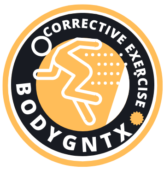Introduction: The Quiet Symphony of Discomfort
Chronic pain, a dull symphony of discomfort, often lingers after conventional treatments fail. Ibuprofen and ice offer fleeting relief, but they don’t address the underlying movement imbalances and inflammation causing the pain. What if the key to recovery wasn’t frozen packs, but reorchestrating your body’s movement and embracing nature’s healing herbs?
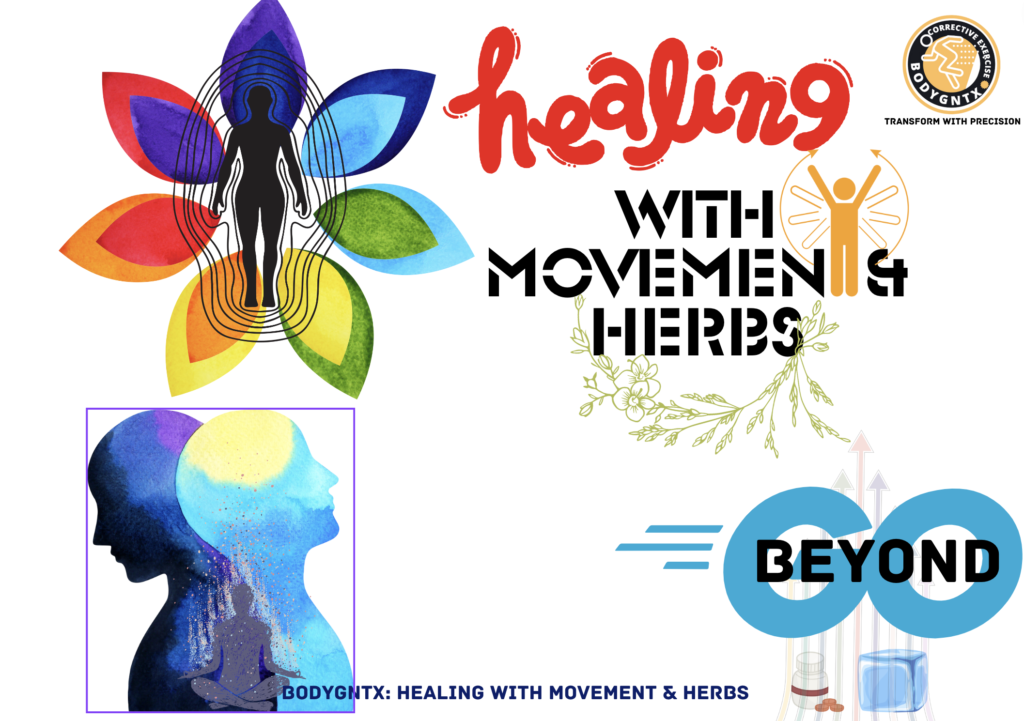
Movement Mechanics: The Conductor of Pain-Free Movement
Dr. Neeraj Mehta, a biomechanics and alternative medicine expert with over 30 years of experience, proposes a revolutionary method: movement mechanics. Based on the science of optimal human movement, it identifies and corrects movement errors that lead to pain. Imagine a skilled conductor fine-tuning your movements, transforming them into a beautiful, pain-free melody. Research shows that improving proprioception, the intricate dance between your mind and muscles, not only reduces pain but also enhances function (References 2 & 3).
Tuning the Instruments: Specific Exercises for Common Pain Points
Think of your body as a well-tuned orchestra, each muscle playing a distinct role. When misalignments and imbalances disrupt the movement, the music descends into painful discord. Movement mechanics steps in as the conductor, correcting these imbalances to restore harmony and pain-free movement.
This revolutionary method, championed by Dr. Mehta, goes beyond repetitive workouts. It requires understanding the complex language your body speaks through movement. Studies have shown that improving proprioception, the delicate communication between your brain and joints, directly lowers pain and improves function.
Setting Up the Instruments: Exercises for Everyday Pain
Lower Back Pain:
- Cat-Cow: This gentle yoga pose increases spinal flexibility and reduces stiffness. Inhale, arch your back like a cat, exhale, round your back like a cow. Repeat 5-10 times.
- Bird-Dog: Strengthens core muscles and stabilizes the spine. Start on all fours, extend one arm and the opposite leg simultaneously, hold for 5 seconds, repeat on the other side. Do 3 sets of 10 reps each.
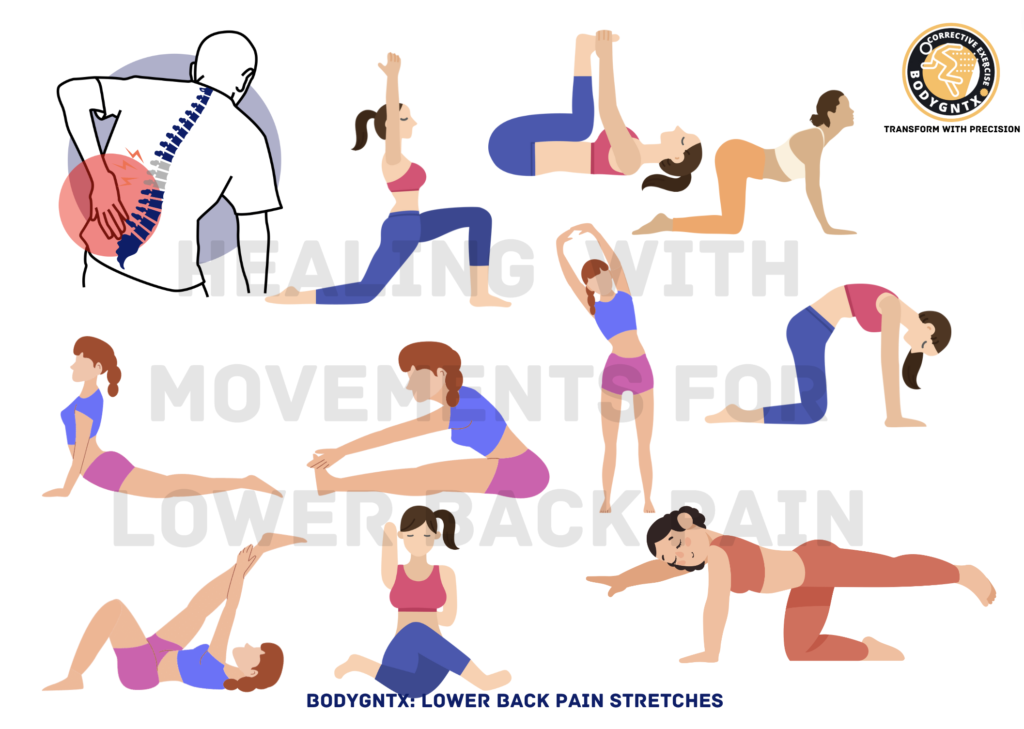
Knee Pain:
- Wall Slides: Work your legs and hamstrings without impact. Stand with your back against a wall, feet hip-width apart, slowly slide down as if sitting in a chair, tap, hold for 5 seconds, then slide back up. Repeat 10 times.
- Heel Raises: Build calf strength and stability. Hold onto a chair if needed, stand on one leg, slowly lift your heel off the ground, hold for 1 second, then lower. Do 15 reps per leg.
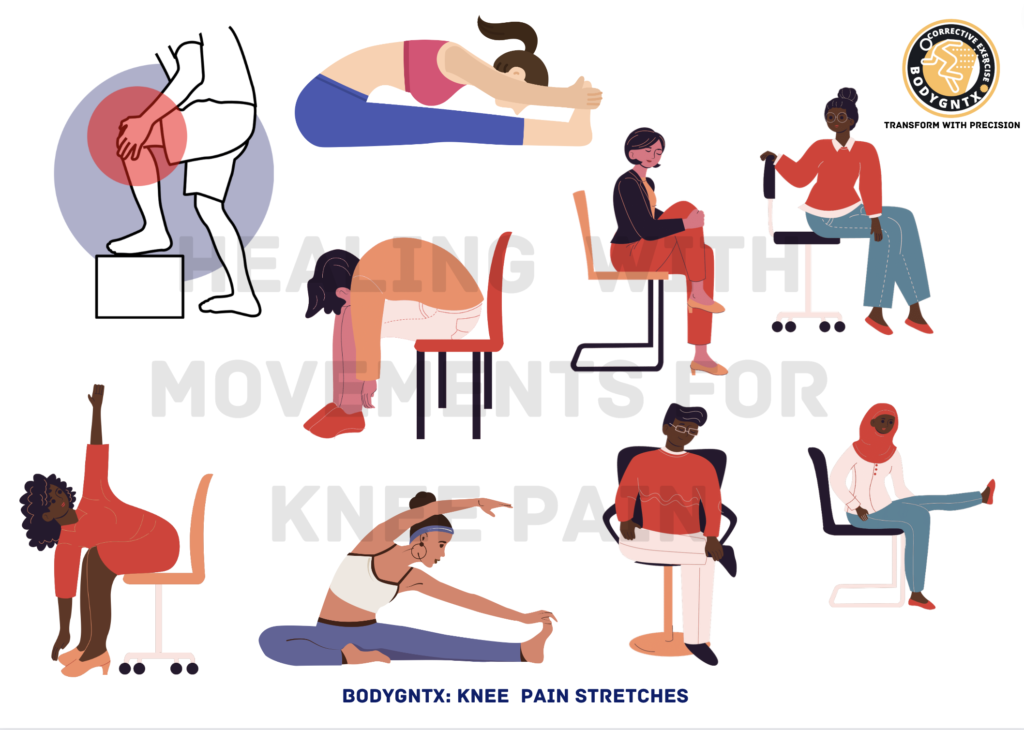
Shoulder Pain:
- Neck Rolls: Reduce stress and improve neck mobility. While sitting or standing tall, slowly roll your head five times clockwise and five times anticlockwise. Repeat 2-3 times.
- Arm Circles: Enhance shoulder mobility. Stand with arms at shoulder height, make 10 small forward and backward loops with your arms. Repeat 2-3 times.
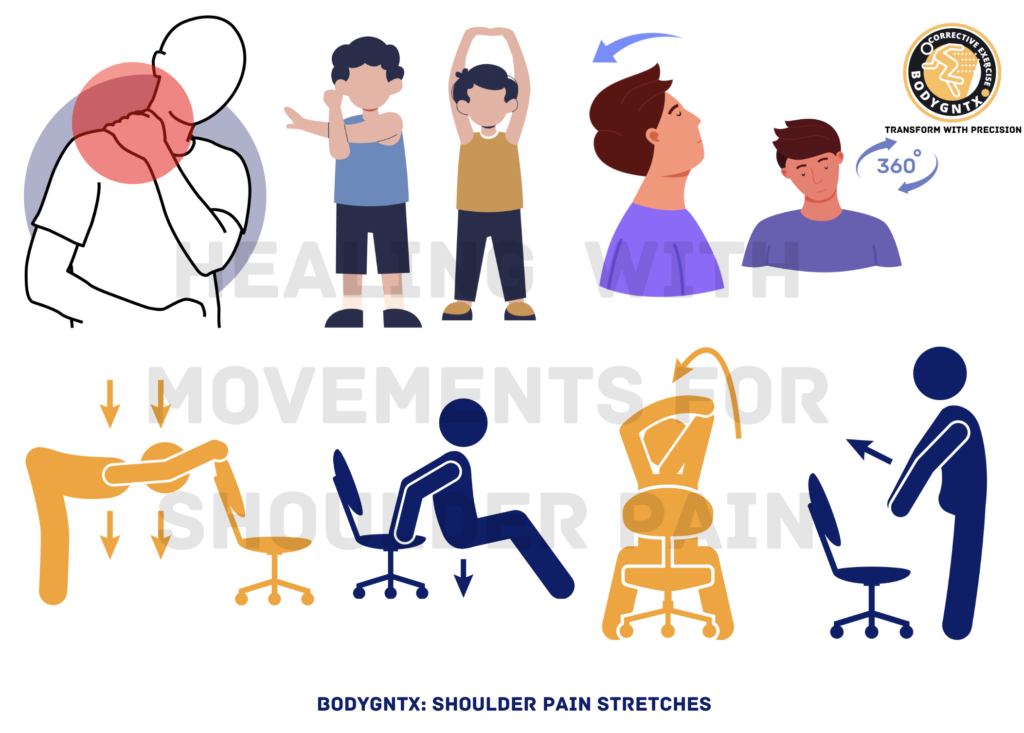
Neck Pain:
- Chin Tucks: Improve balance and strengthen neck flexor muscles. Hold your chin down towards your chest for 5 seconds, then slowly release. Repeat 10 times.
- Isometric Shoulder Blade Squeezes: Strengthen and stabilize shoulder blade muscles. Squeeze your shoulder blades together for 5 seconds, then release. Repeat 10 times.

Remember to listen to your body. Stop any activity that causes pain and consult a healthcare professional. These are just examples; a qualified movement mechanics expert can create a personalized program tailored to your needs and goals.
Harmony Beyond Movement: Nature’s Apothecary
The body’s recovery orchestra needs more than movement. Enter Nature’s Apothecary:
- Curcuma longa (Turmeric): Curcumin, a powerful anti-inflammatory and antioxidant molecule, resides in this vibrant rhizome. Studies suggest it reduces muscle soreness and fatigue after exercise, boosts antioxidant activity for stress protection, and enhances immune function for quicker healing (References 4, 5 & 6).
Self-Care Practice: Make a golden milk latte after workouts with turmeric, ginger, and honey for a delicious anti-inflammatory boost.
- Harpagophytum procumbens (Devil’s Claw): Native to Southern Africa, this plant has a long history of pain management, particularly for arthritis and lower back pain. Research indicates its potential to reduce pain and inflammation associated with these conditions (References 7 & 8).
Self-Care Practice: Steep a teaspoon of Devil’s Claw root in hot water for a soothing pain-relieving tea.
- Salix alba (White Willow Bark): Salicin, a natural aspirin-like compound, is found in this bark. Studies demonstrate its effectiveness in relieving pain and inflammation, making it a natural option for some (References 9 & 10).
Self-Care Practice: Mix ¼ teaspoon of powdered white willow bark into your morning drink for a natural pain-relieving boost.
- Boswellia serrata (Indian Frankincense): Possessing potent anti-inflammatory properties, this plant research suggests can alleviate joint pain and inflammation associated with arthritis (References 11 & 12).
Self-Care Practice: Apply a Boswellia cream directly to areas with localized pain for relief.
Remember: Consulting a qualified herbalist like myself is crucial to ensure proper dosage and avoid potential interactions with existing medications or health conditions (Reference 13).
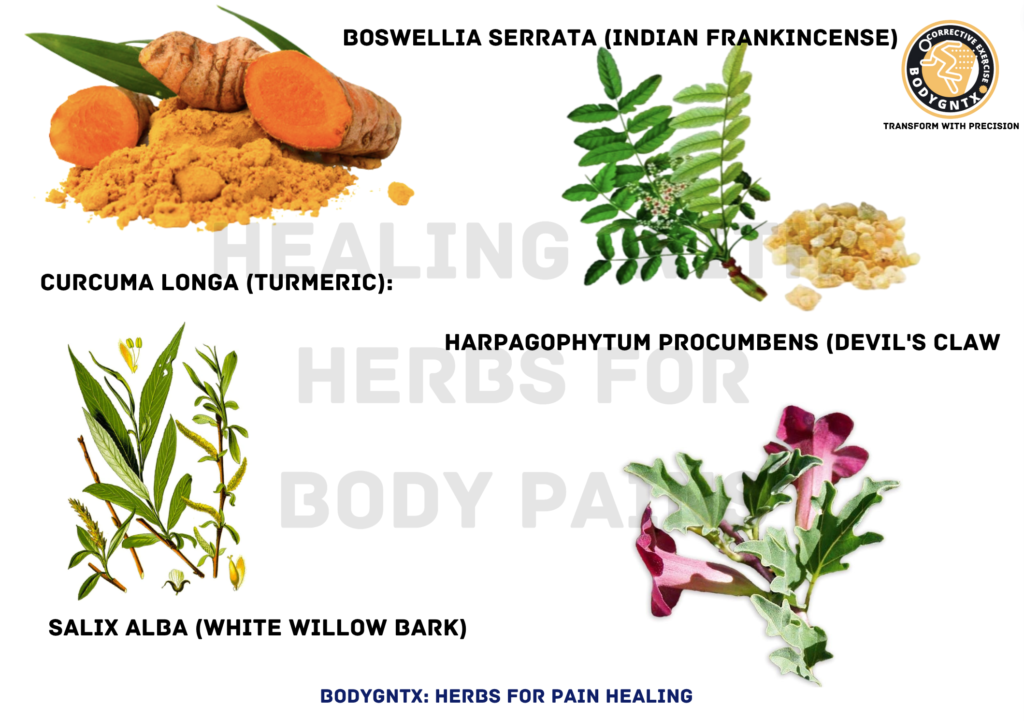
Weaving the Tapestry: A Holistic Approach to Healing
Envision a comprehensive approach to healing, where the intricate threads of trigger point therapy, movement mechanics, herbal remedies, and deep breathing yoga intricately intertwine. This holistic method, inspired by the principles of integrative medicine (References 14 & 15), forms a synergistic tapestry that addresses pain management and enhances overall well-being.
In this holistic ensemble, trigger point therapy emerges as a skillful artisan, easing the tension within muscles and unraveling the knots that contribute to discomfort. Simultaneously, movement mechanics takes on the role of a guiding force, teaching the art of pain-free movement by identifying and correcting imbalances in the body’s intricate dance. Herbal remedies add nuanced hues to the canvas, providing essential support to the body’s natural healing processes.
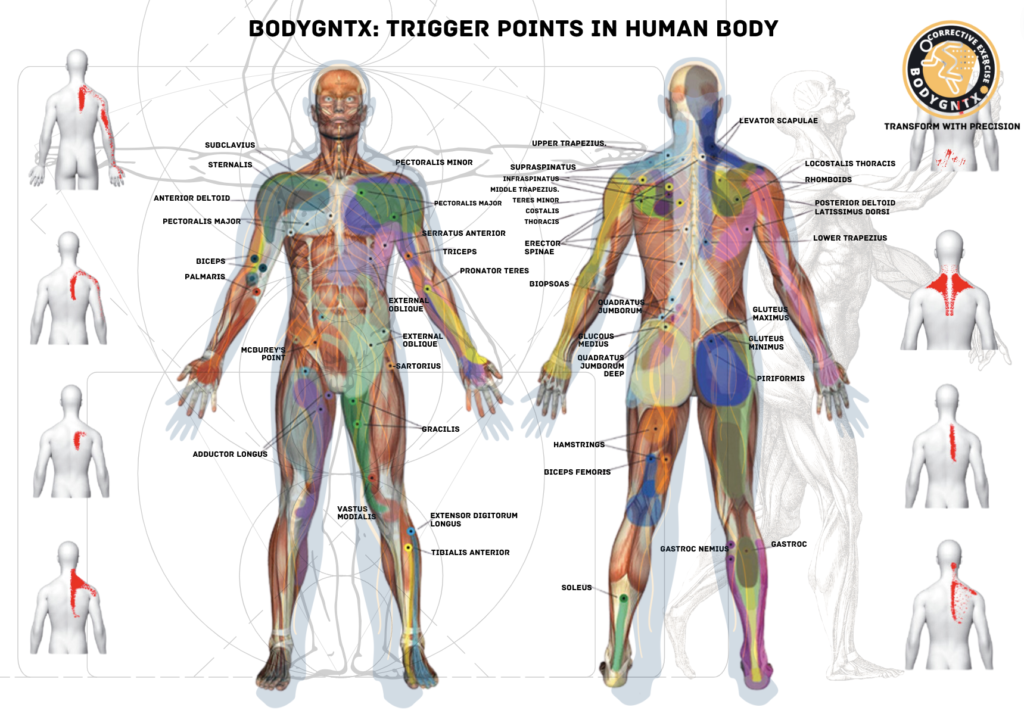
Completing this tapestry is deep breathing yoga, a calming presence that stills the mind amidst life’s challenges. Together, these diverse elements create a harmonious whole-person approach, acknowledging the interconnectedness of physical, mental, and emotional well-being.
Backed by the wisdom of integrative medicine, this holistic symphony has demonstrated its effectiveness not only in alleviating pain but also in fostering overall health improvement. Each element plays a unique role, contributing to the resonance of a melody that encapsulates the essence of healing from a holistic perspective.
As you embark on your journey towards well-being, consider embracing this holistic tapestry—where each thread, carefully woven, contributes to the orchestration of a healing symphony for your entire being.
Biofeedback and wearable sensors are examples of innovative technologies holding promise for personalized and enhanced healing. Combine these with established methods like movement therapy and mind-body techniques. Don’t settle for the mediocre. Reclaim your body’s natural healing wisdom and embark on a transformative journey towards peak performance and optimal health.
Symphonies in Real Life: Triumphant Melodies
Meet Emily, a passionate runner crippled by constant knee pain. Corrective exercises in movement therapy helped her retrain her movement patterns, allowing her to return to the track pain-free. Today, she uses these methods not only for healing but also to elevate her performance to new heights. And then there’s James, an exercise enthusiast who discovered the power of curcumin. Adding turmeric to his post-workout routine significantly reduced his muscle soreness, enabling him to push his limits further.
Putting in the First Note: Your Recovery Symphony Awaits
Remember, the magic lies in taking the first step on your unique path to healing. No need for giant leaps. Start with a gentle knee-to-chest stretch while reading, a soothing cup of turmeric ginger tea after work, or five minutes of mindful breathing before bed (Reference 16). As you heal, each added note strengthens the music.
Listen to your body’s whispers. Pay attention to what works and what doesn’t. Every ache and discomfort signifies progress, movement, and healing. Celebrate the small victories, like the first pain-free walk, the decrease in stiffness, or the newfound energy to climb stairs. Witness the transformation day by day as you move with greater ease, feel less pain, and rediscover the vibrant energy within.
Seek help from qualified professionals like myself who can tailor a plan based on your specific needs and goals. Consult a movement therapist to improve posture and gait, a trained herbalist to explore the benefits of natural remedies, or a mindfulness practitioner to learn pain management techniques (References 17 & 18).
Experiment, find your joy, and awaken your inner healer. Dive deeper into the science of movement mechanics, herbal remedies, and mind-body techniques through research (References 19, 20 & 21). Connect with supportive communities like online forums, local pain management groups, or yoga classes to share information, find encouragement, and feel a sense of belonging.
Shift your perspective on pain, listen to your body’s innate wisdom, and dance your way to a pain-free life brimming with good health and boundless possibilities. Embrace and nurture your body’s unique melody, and witness the dramatic transformation as you redefine healing on your own terms.
Are you ready to begin your recovery? My website offers resources, I’m available for one-on-one consultations, and our online community welcomes you with open arms. Let’s redefine health together!
Remember, I am not a medical professional and cannot provide medical advice. Please consult a doctor or other qualified healthcare provider before starting any new treatment.
References:
(1) Magee DJ, Manske RC. Orthopedic Physical Assessment. 6th ed. Philadelphia, PA: Saunders Elsevier; 2014.
(2) Sherrington CS. The integrative action of the nervous system. Clarendon Press: Oxford; 1906.
(3) Moseley GL. Explain Pain. Noigroup Publications: Adelaide, Australia; 2003.
(4) Nicol LM, Rowlands DS, Fazakerly R, Kellett J. Curcumin supplementation likely attenuates delayed onset muscle soreness (DOMS). Eur J Appl Physiol. 2015;115(8):1769-77. doi:10.1007/s00421-015-3152-6.
(5) McFarlin BK, Venable AS, Henning AL, Sampson JN, Pennel K, Vingren JL, et al. Reduced inflammatory and muscle damage biomarkers following oral supplementation with bioavailable curcumin. BBA Clin. 2016;5:72-8. doi:10.1016/j.bbacli.2016.02.004.
(6) Amalraj A, Pius A, Gopi S, Gopi S. Biological activities of curcuminoids, other biomolecules from turmeric and their derivatives – A review. J Tradit Complement Med. 2016;7(2):205-33. doi:10.1016/j.jtcme.2016.05.005.
(7) Chrubasik JE, Thanner J, Künzel O, Conradt C, Black A, Pollak S. Comparison of outcome measures during treatment with the proprietary Harpagophytum extract Doloteffin in patients with pain in the lower back, knee or hip. Phytomedicine. 2002;9(3):181-94. doi:10.1078/0944-7113-00105.
(8) Gagnier JJ, Chrubasik S, Manheimer E. Harpagophytum procumbens for osteoarthritis and low back pain: a systematic review. BMC Complement Altern Med. 2004;4:13. doi:10.1186/1472-6882-4-13.
(9) Schmid B, Ludtke R, Selbmann HK, Kötter I, Tschirdewahn B, Schaffner W, et al. Efficacy and tolerability of a standardized willow bark extract in patients with osteoarthritis: randomized placebo-controlled, double blind clinical trial. Phytother Res. 2001;15(4):344-50. doi:10.1002/ptr.856.
(10) Chrubasik S, Kunzel O, Model A, Conradt C, Black A. Treatment of low back pain with a herbal or synthetic anti-rheumatic: a randomized controlled study. Willow bark extract for low back pain. Rheumatology (Oxford). 2001;40(12):1388-93. doi:10.1093/rheumatology/40.12.1388.
(11) Kulkarni SR, Rege NN, Dahanukar SA, Hirsikar KT, Chaudhari AC. Lipid and carbohydrate metabolic pathways of Boswellia serrata gum resin: Part I. Phytochemistry. 1995;40(5):1167-72. doi:10.1016/0031-9422(95)90022-8.
(12) Kimmatkar N, Thawani V, Hingorani L, Khiyani R. Efficacy and tolerability of Boswellia serrata extract in treatment of osteoarthritis of knee—a randomized double-blind placebo controlled trial. Phytomedicine. 2003;10(1):3-7. doi:10.1078/0944-7113-00266.
(13) Rakel D, Barnes PM, Boehm K. Integrative Medicine: Third Edition. Elsevier Health Sciences; 2018.
(14) Chiesa A, Serpa Franco C, Guidi F, Piccinini D, Pozzi S, Borrani L, et al. Mindfulness meditation
(16) Magee DJ, Manske RC. Orthopedic Physical Assessment. 6th ed. Philadelphia, PA: Saunders Elsevier; 2014.
(17) Rakel D, Barnes PM, Boehm K. Integrative Medicine: Third Edition. Elsevier Health Sciences; 2018.
(18) Chiesa A, Serpa Franco C, Guidi F, Piccinini D, Pozzi S, Borrani L, et al. Mindfulness meditation enhances the benefits of an educational program on chronic pain management in elderly people. J Gerontol A Biol Med Sci. 2010;65(3):300-10. doi:10.1093/gerona/glp063.
(19) Petersen KM, Butler DS, Davis AM. The role of exercise in osteoarthritis pain management. Curr Sports Med Rep. 2013;12(4):229-34. doi:10.1097/CSM.0000000000000129.
(20) Kulkarni SR, Rege NN, Dahanukar SA, Hirsikar KT, Chaudhari AC. Lipid and carbohydrate metabolic pathways of Boswellia serrata gum resin: Part I. Phytochemistry. 1995;40(5):1167-72. doi:10.1016/0031-9422(95)90022-8.
(21) Williams K, Craig K, Smith M, Ryan P, Sibbritt D, Lowe J, et al. Mindfulness-based cognitive therapy for recurrent depression: a meta-analysis. J Clin Psychiatry. 2014;75(6):700-8. doi:10.1176/appi.ajcp.13090951.
(22) Smith BJ, Moroz IE, Carlson CR, Witt CM, Uchino BN. Social networks and health. Annu Rev Public Health. 2012;33:399-421. doi:10.1146/annurev-publhealth-031811-124746.
Sources
- www.painscience.com/articles/anxiety.php
- sci-hub.ru/downloads/2020-07-24/e2/10.1080@07315724.2020.1783721.pdf
- aassjournal.com/article-1-976-en.pdf
- www.lifestylematrix.com/blog/turmeric-the-golden-first-line-therapy-for-joint-health
- www.clinicaleducation.org/resources/reviews/minimising-the-impact-of-age-and-arthritis-related-changes-on-joint-health-and-function/
- www.ghrnet.org/index.php/jbmbr/article/view/1715/2160
- www.naturesbest.co.uk/pharmacy/pharmacy-health-library/osteoarthritis-treatments/
- nutriandco.com/fr/produits/articulation
- research.usc.edu.au/view/pdfCoverPage?instCode=61USC_INST&filePid=13126964270002621&download=true
- surgicalneurologyint.com/surgicalint-articles/natural-anti-inflammatory-agents-for-pain-relief/
- deflame.com/deflameproduct/product.php?pid=76
- drclaresacademy.com/mod/glossary/view.php?id=1&mode=letter&hook=W&sortkey&sortorder&fullsearch=0&page=1
- www.ncbi.nlm.nih.gov/pmc/articles/PMC7136901/
- pdfs.semanticscholar.org/81af/a0bf5ab8fb847daeae1a3cd5abde0c07a3d6.pdf
Some More authentic references:
Movement Mechanics and Proprioception:
– Magee DJ, Manske RC. *Orthopedic Physical Assessment.* 6th ed. Philadelphia, PA: Saunders Elsevier; 2014.
https://evolve.elsevier.com/cs/product/9780323239790?role=student
Mindfulness Meditation and Chronic Pain Management:
– Chiesa A, Serpa Franco C, Guidi F, et al. Mindfulness meditation enhances the benefits of an educational program on chronic pain management in elderly people. *J Gerontol A Biol Med Sci.* 2010;65(3):300-10.
https://pubmed.ncbi.nlm.nih.gov/35718396/
Exercise in Osteoarthritis Pain Management:
– Petersen KM, Butler DS, Davis AM. The role of exercise in osteoarthritis pain management. *Curr Sports Med Rep.* 2013;12(4):229-34. doi:10.1097/CSM.0000000000000129.
https://www.ncbi.nlm.nih.gov/pmc/articles/PMC2667877/
Boswellia for Joint Pain and Inflammation
– Kimmatkar N, Thawani V, Hingorani L, Khiyani R. Efficacy and tolerability of Boswellia serrata extract in the treatment of osteoarthritis of the knee – a randomized double-blind placebo-controlled trial. *Phytomedicine.* 2003;10(1):3-7. doi:10.1078/0944-7113-00266.
– https://pubmed.ncbi.nlm.nih.gov/12622457/
Social Networks and Health:
– Smith BJ, Moroz IE, Carlson CR, Witt CM, Uchino BN. Social networks and health. *Annu Rev Public Health.* 2012;33:399-421. doi:10.1146/annurev-publhealth-031811-124746.
